5 Ways to Make Ravioli From Scratch
5 easy ways to make ravioli from scratch. They come in all kinds of shapes and sizes and are the ideal starting point if you are new to making filled pasta at home. It takes a bit of effort, but the results are well worth it. To shape the ravioli, you can use dedicated ravioli equipment (see options below) or simply just use some tools that you most likely already have at home. Ravioli are traditionally made with thin sheets of fresh pasta and can be filled with whatever your heart desires. For this recipe, I used a simple lemon ricotta filling, but feel free to experiment and use a filling of your choice.
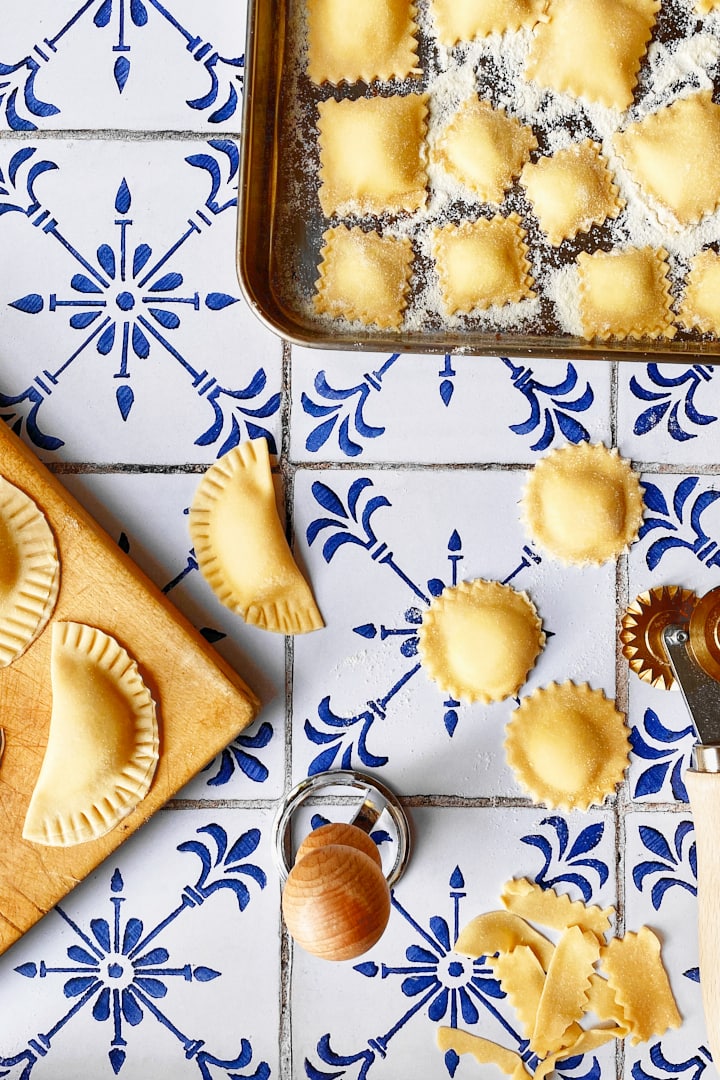
Ingredients and Tools You’ll Need

Step-by-Step Instructions
Step 1
Prepare one batch of fresh pasta dough. Knead vigorously for 10 minutes, wrap the dough in cling film and let it rest for at least 30 minutes at room temperature. For detailed instructions, have a look at this italian pasta dough recipe.
Step 2
While the pasta dough is resting, prepare the filling. In a bowl, mix the ricotta, zest and juice of one small lemon, grated parmesan cheese, salt, and pepper. Stir until smooth and well combined. Spoon the filling into a piping bag.
Step 3
Dust a baking tray with semolina flour (“semolina rimacinata di grano duro”) to lay out the finished ravioli. Take about a quarter of the pasta dough and keep the rest well wrapped. Follow the instructions to roll the dough out into fresh pasta sheets. I use a Marcato Atlas 150 Wellness pasta machine and finish at setting 7. I pass the dough through the final setting twice. Choose one of the methods below to shape your homemade ravioli.
Step 4
Cook the ravioli in salted boiling water for about 2-3 minutes. Make sure to not overcook them. Taste one of them once they float to the top to check if they are ready. They should be tender at the thickest point of the dough, but still have a little bite to them. Once cooked, use a slotted spoon or pasta spider to gently lift the ravioli out of the water and transfer them directly to the sauce. Add a splash of cooking water and cook a little longer until the ravioli are evenly coated with sauce. Serve and enjoy!

5 Ways to Make Ravioli at Home
1. Use a Ravioli Mold
Lightly dust a ravioli mold with semolina flour. This prevents the pasta from sticking to the mold. Drape a thin pasta sheet over the ravioli mold and use your knuckle to gently press it into the indentations. Evenly pipe the filling into the dents. Be careful to not use too much, or it will leak when you seal the ravioli.
Check the dough: If it feels slightly tacky, you can skip the next step. However, when the pasta feels a bit dry, you can use a fine mist water spray bottle and very lightly spray the pasta from a distance of about 30 cm. This will rehydrate the dough and help the pasta sheets to stick together. Be careful to not use too much water, or the dough will get soggy and stick to the work surface. Lay a second pasta sheet on top. Gently smooth it out with your palms and squeeze out any excess air. If there are any air pockets in your ravioli, they might burst when you cook them. Then, use a small wooden rolling pin and roll over the mold from bottom to top with even pressure to seal the pasta. Carefully lift it out of the mold. Use a fluted pasta wheel and follow the imprints of the mold to cut the ravioli into individual squares. Remove the scraps and save them, wrapped in cling film. You can roll the scraps out again (which is what I prefer to do) or use them in soup. Lay the finished ravioli on the prepared baking tray in a single layer. Repeat the process with the remaining dough and filling.
2. Use a Ravioli Stamp
Lay a pasta sheet on a wooden board. Pipe evenly sized dollops of filling (about one heaped teaspoon each) on the sheet, spacing them about 4 cm apart. If the pasta sheet feels dry, lightly mist it with water from a distance of about 30 cm. Lay a second sheet of pasta on top and drape it over the filling. Use your index fingers and gently press around each dollop of filling. Squeeze out any excess air. Use a round ravioli stamp, place it over each mound and press straight down. Then, rotate the stamp clockwise while maintaining even pressure to ensure a clean cut. Remove and save the scraps. Lay the finished ravioli on the prepared baking tray. Repeat the process with the remaining dough and filling.
3. The Freestyle Method
Lay a pasta sheet on a wooden board. Pipe evenly sized dollops of filling (about one heaped teaspoon each) on the sheet, spacing them about two finger widths apart. With the “Freestyle Method” you can also make bigger ravioli and increase the amount of filling as you wish. If the pasta sheet feels dry, lightly mist it with water from a distance of about 30 cm. Lay a second sheet of pasta on top and drape it over the filling. Use your index fingers and gently press around each mound. Squeeze out any excess air and seal the pasta. Use a fluted pasta wheel and cut in between the mounds to create individual square ravioli. Remove and save the scraps. Lay the finished ravioli on the prepared baking tray in a single layer. Repeat the process with the remaining dough and filling.

4. The Fold Method
Place a sheet of pasta on a wooden board. Fold it in half lengthwise and lightly press down on the fold to mark the center line. Then, unfold it and lay it out flat again. Pipe evenly sized dollops of filling (about one heaped teaspoon each) directly on the center line, spacing them about 2 cm apart. If the pasta sheet feels dry, lightly mist it with water from a distance of about 30 cm. Fold the dough over again and make sure the edges line up. Use your index fingers and gently press around each dollop of filling. Squeeze out any excess air and seal the pasta. Use a fluted pasta wheel to cut along the long edge of the pasta and then in between the mounds to create individual rectangular ravioli. Remove and save the scraps. Lay the finished ravioli on the prepared baking tray in a single layer. Repeat the process with the remaining dough and filling.

5. Mezzelune (Half Round Ravioli)
Place a sheet of pasta on a wooden board. Use a sharp round cookie cutter and cut out circles (about 7 cm in diameter). Remove and save the scraps. Pipe the filling (about a tablespoon) in the center of each round. If the pasta feels dry, lightly mist it with water from a distance of about 30 cm. Fold each round in half to create a half-moon shape and make sure the edges are lined up. Use your index fingers and gently press around the filling. Squeeze out any excess air and seal the pasta. Use a fluted pasta wheel to cut along the rounded edge of the pasta, or use a fork to crimp the edges. Lay the finished mezzelune on the prepared baking tray in a single layer. Repeat the process with the remaining dough and filling.

Tips & Tricks
More Pasta Recipes You May Like:

5 Ways to Make Ravioli at Home
Equipment
- 1 Pasta machine or KitchenAid pasta roller attachment – I use a Marcato Atlas 150 Wellness hand-cranked pasta machine.
- Ravioli mold and small wooden rolling pin – this is usually sold together in sets.
- Ravioli stamp – they are available in different shapes and sizes. For this recipe, I used a round stamp (ca. 5 cm in diameter).
- Fluted pasta wheel or sharp knife – to cut the ravioli into individual pieces.
- Round cookie cutter – to make Mezzelune (half-moon ravioli).
- fork – to crimp the edges of the ravioli in case you don't have fluted pasta wheel.
- Wooden board – helps to keep your work surface clean and absorbs excess moisture from the dough
- Piping bag or teaspoon – to place the filling on the pasta sheets. Using a piping bag is a lot easier and less messy.
- Baking tray – to lay out your finished ravioli.
- Semolina flour – to dust the baking tray and pasta sheets and prevent sticking – to dust the baking tray and pasta sheets. This prevents sticking.
- Fine mist water spray bottle – to rehydrate the pasta sheets in case they slightly dry out. This helps to seal the pasta and ensures that the pasta sheets stick together.
- Cling film – to cover the baking tray and prevent the finished ravioli from drying out.
Ingredients
For the pasta dough:
- 300 g "Tipo 00" flour – or all-purpose flour with a protein content of 11-12 %
- 100 g Semolina flour (Semolina rimacinata di grano duro) – if you don't have semolina flour you can use Tipo 00 or all-purpose flour instead
- 228 g Eggs – about 4 medium eggs
For the filling:
- 400 g Ricotta cheese
- 80 g Parmesan cheese – grated
- 1 Lemon – juice and zest of one organic lemon
- Salt and pepper – to taste
Instructions
Prepare the pasta dough
- Prepare one batch of fresh egg pasta dough. Knead vigorously for 10 minutes, wrap the dough in cling film and let it rest for at least 30 minutes at room temperature.
Prepare the filling
- While the pasta dough is resting, prepare the filling. In a bowl, mix the ricotta, zest and juice of one small lemon, grated parmesan cheese, salt, and pepper. Stir until smooth and well combined. Spoon the filling into a piping bag.
Shape the ravioli
- Dust a baking tray with semolina flour ("semolina rimacinata di grano duro") to lay out the finished ravioli. Take about a quarter of the pasta dough and keep the rest well wrapped. Roll the dough out into thin pasta sheets. I use a Marcato Atlas 150 Wellness pasta machine and finish at setting 7. Pass the dough through the final setting twice. Please refer to the blog post and the video below for different methods to shape homemade ravioli.
Cook the ravioli
- Cook the ravioli in salted boiling water for about 2-3 minutes. Make sure to not overcook them. Taste one of them once they float to the top to check if they are ready. They should be tender at the thickest point of the dough, but still have a little bite to them. Once cooked, use a slotted spoon or pasta spider to gently lift the ravioli out of the water and transfer them directly to the sauce. Add a splash of cooking water and cook a little longer until the ravioli are evenly coated with sauce. Serve and enjoy!
Video
Nutrition
Do you have any questions about this recipe?
Let me know in the comments!


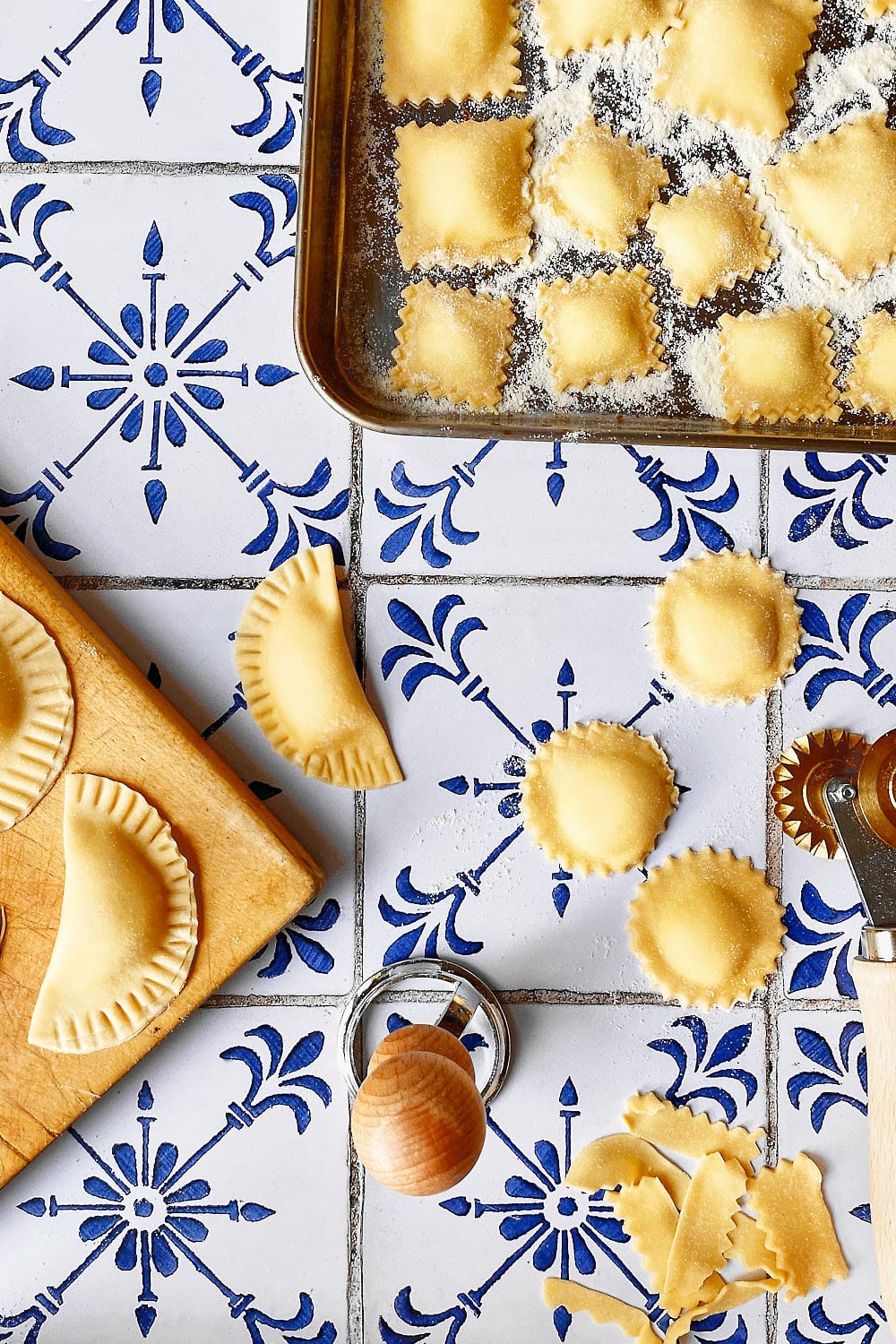





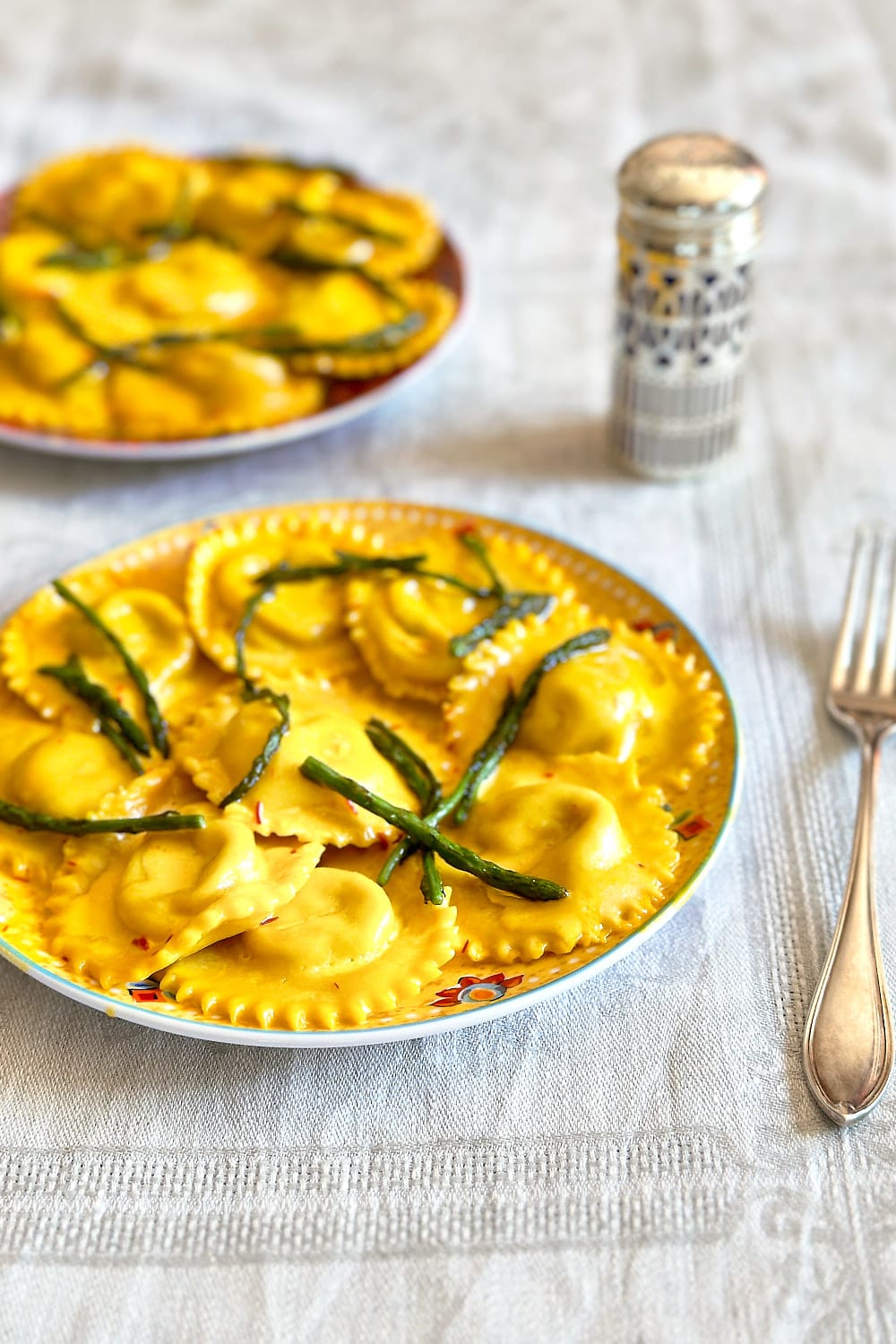
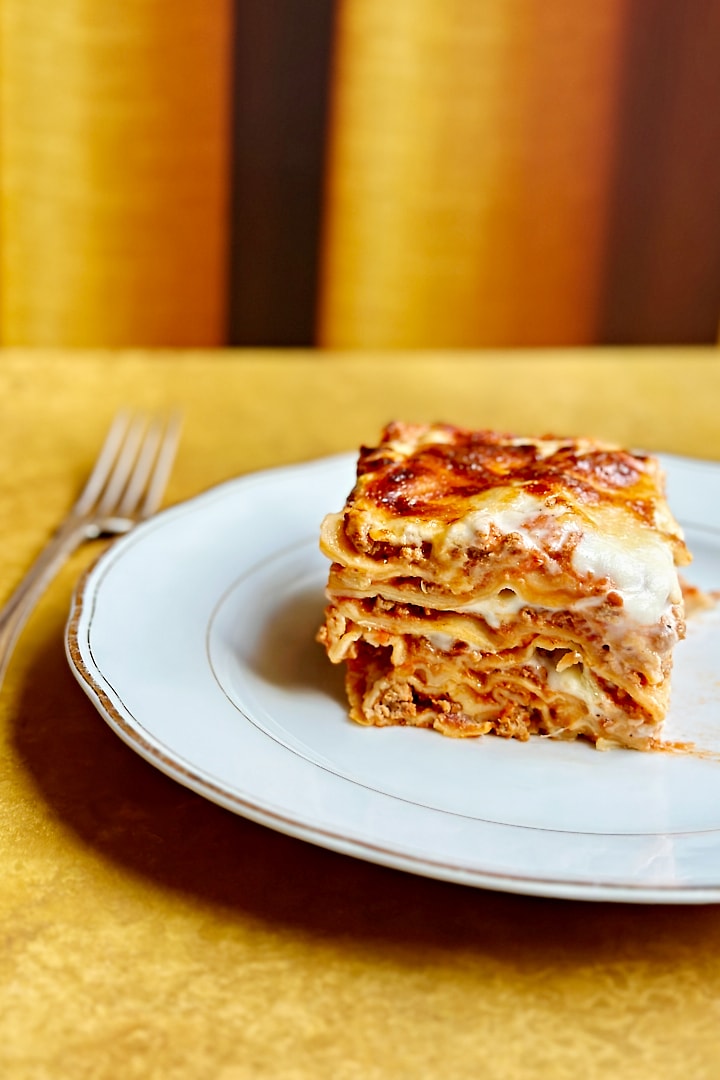
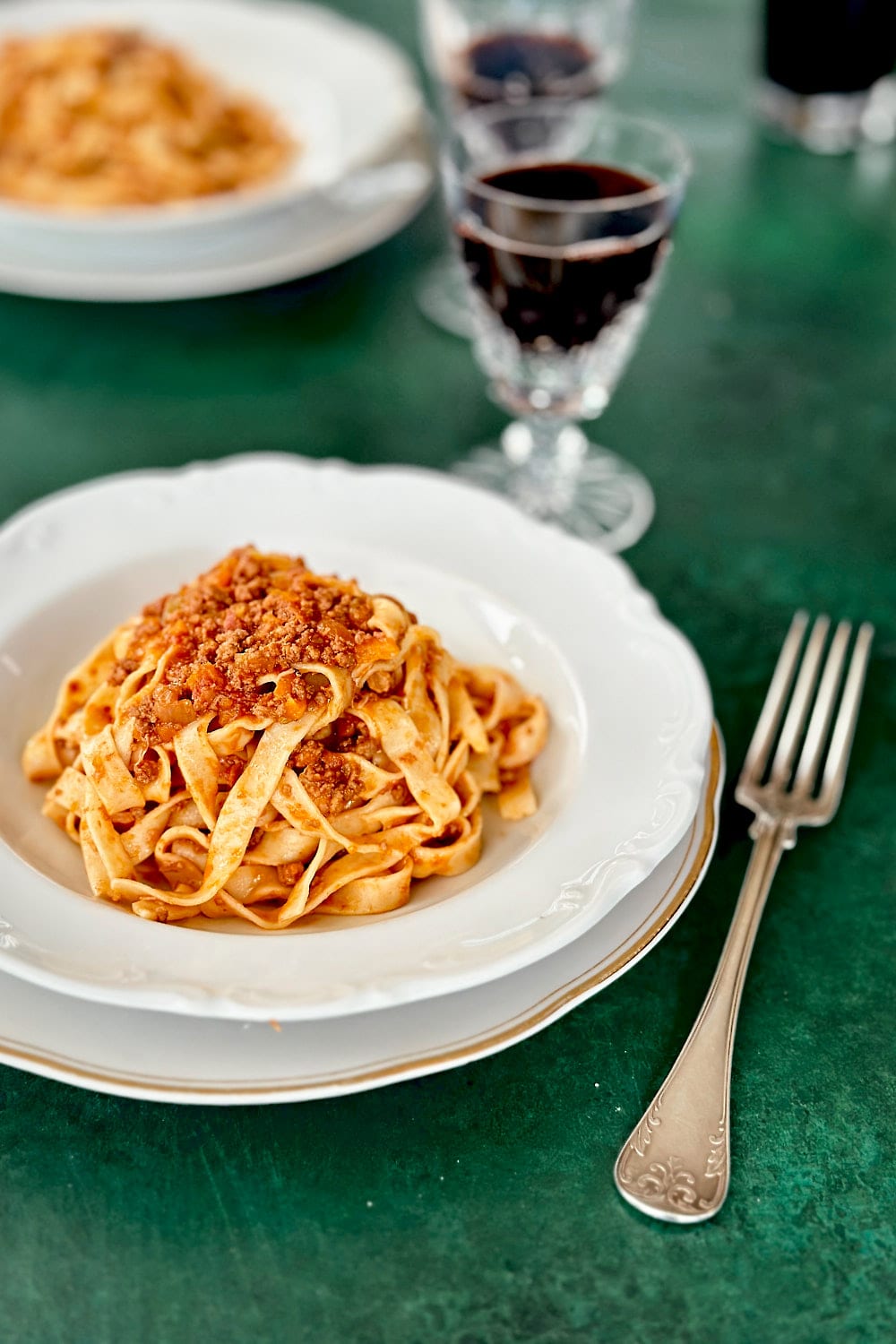
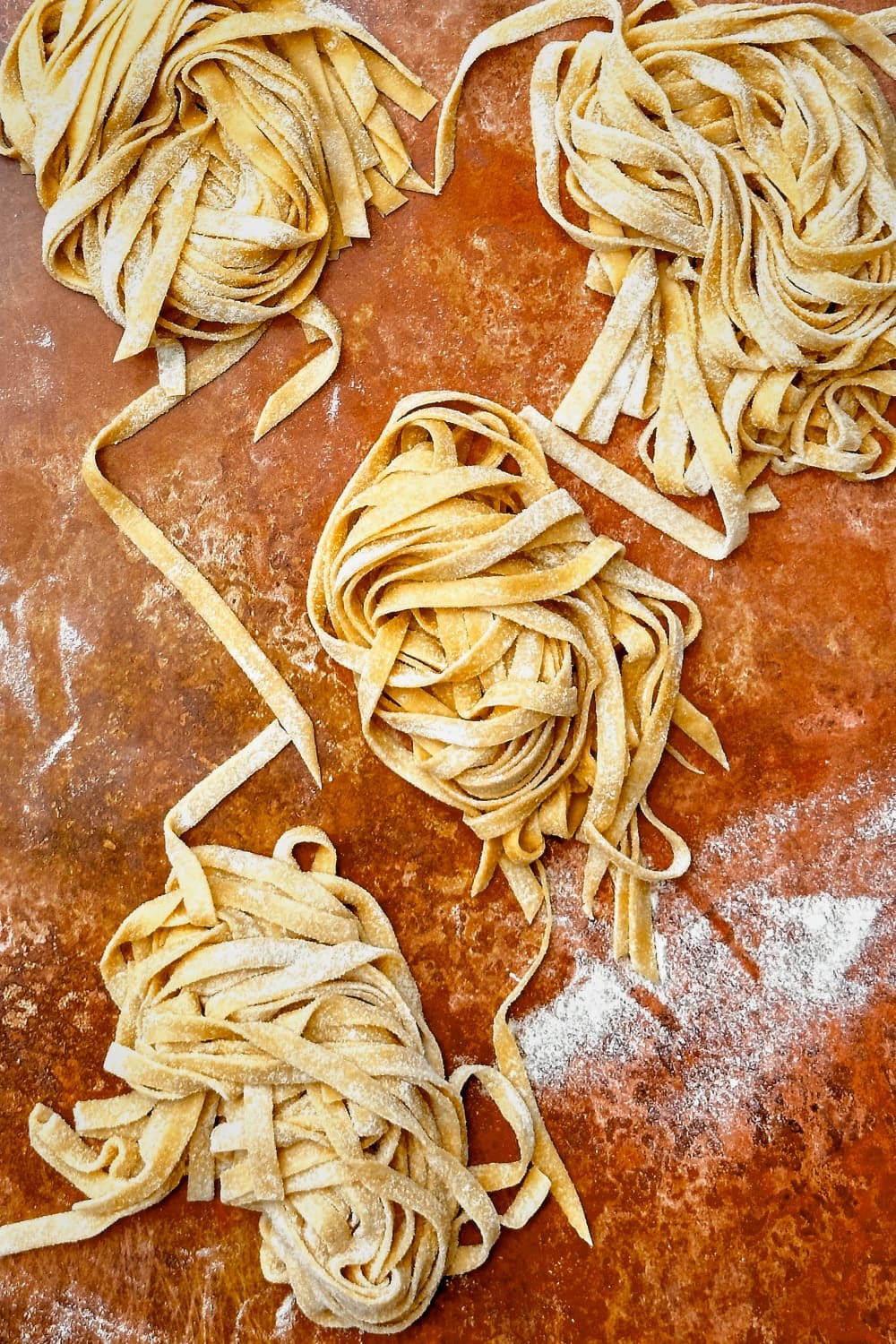
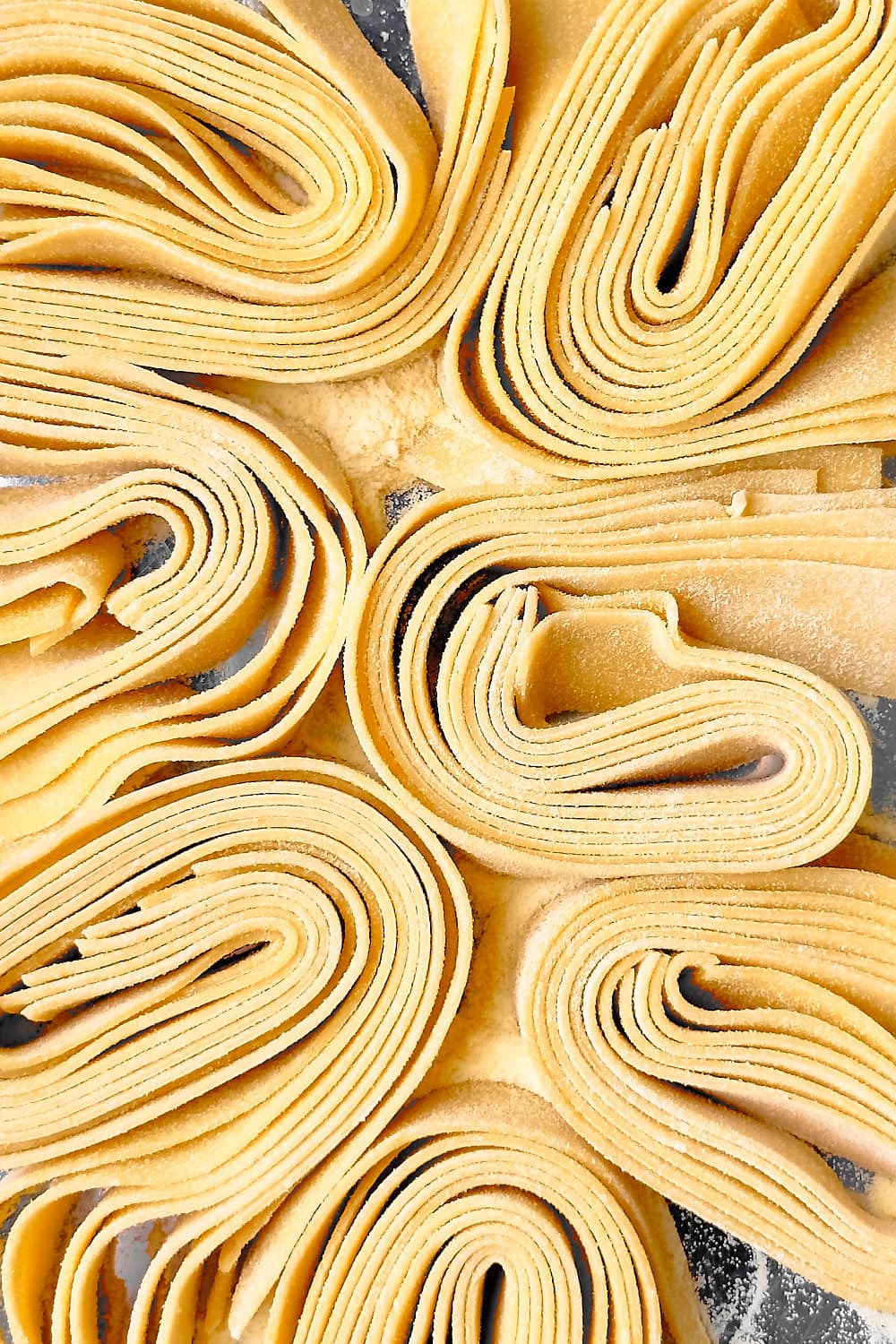

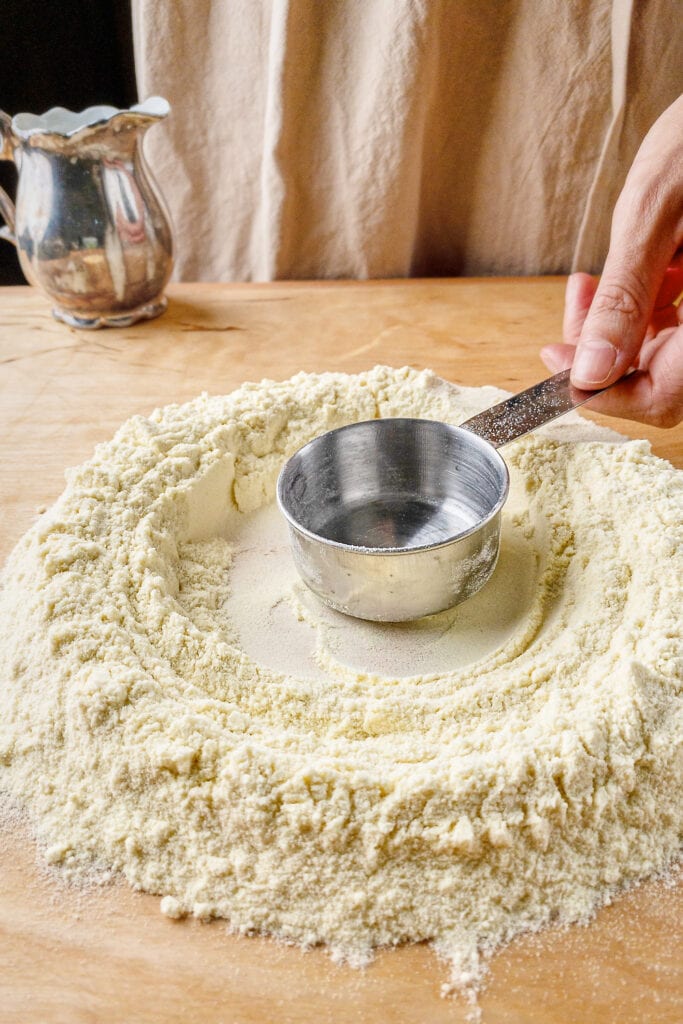
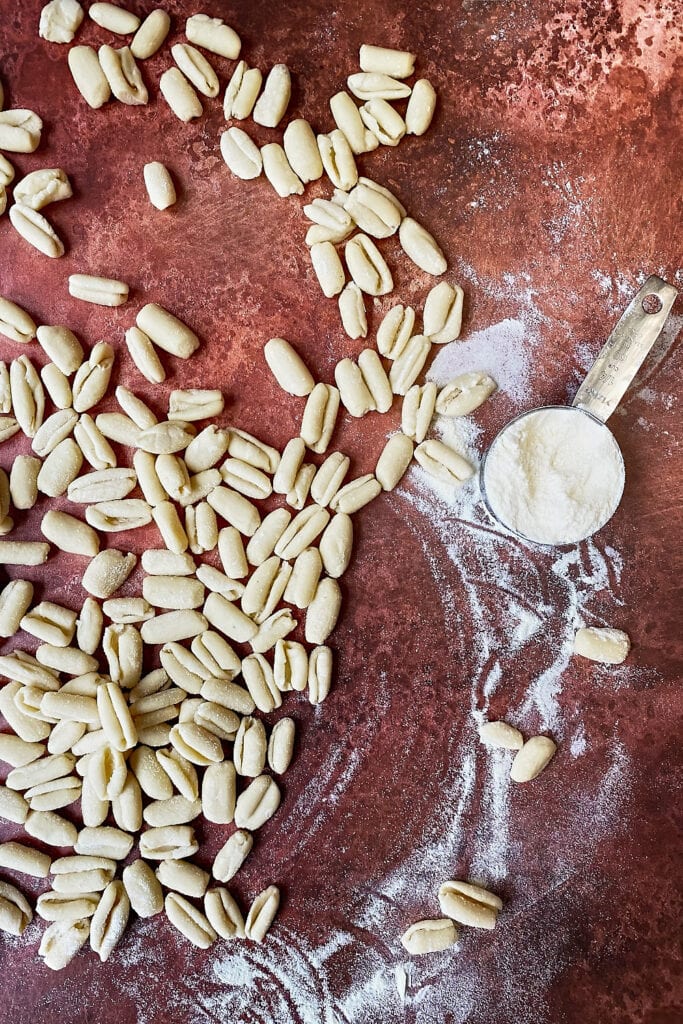
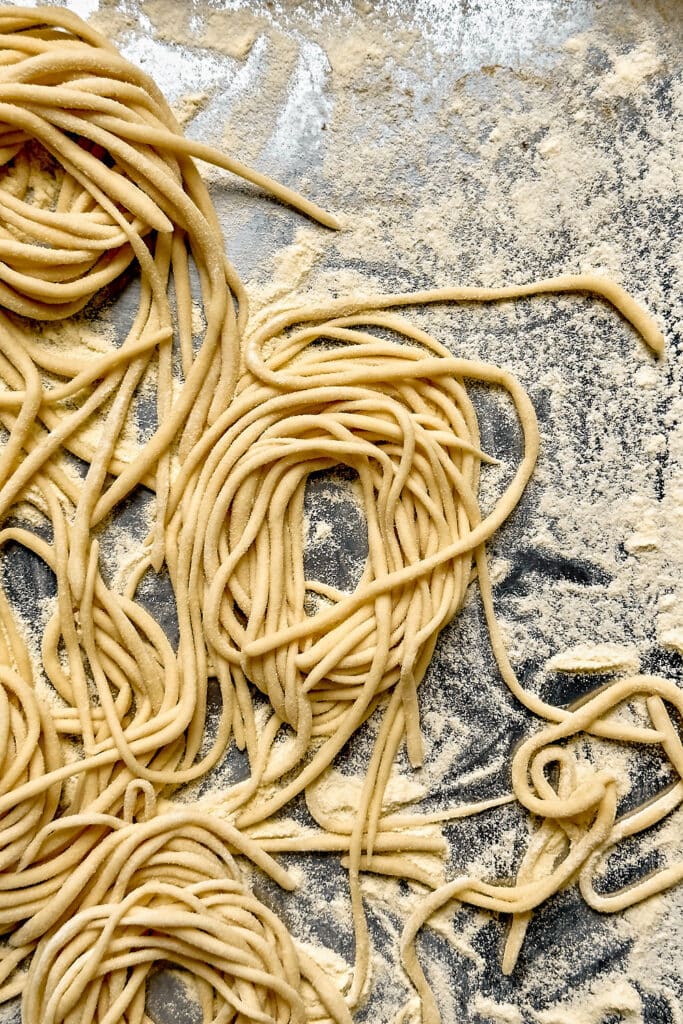
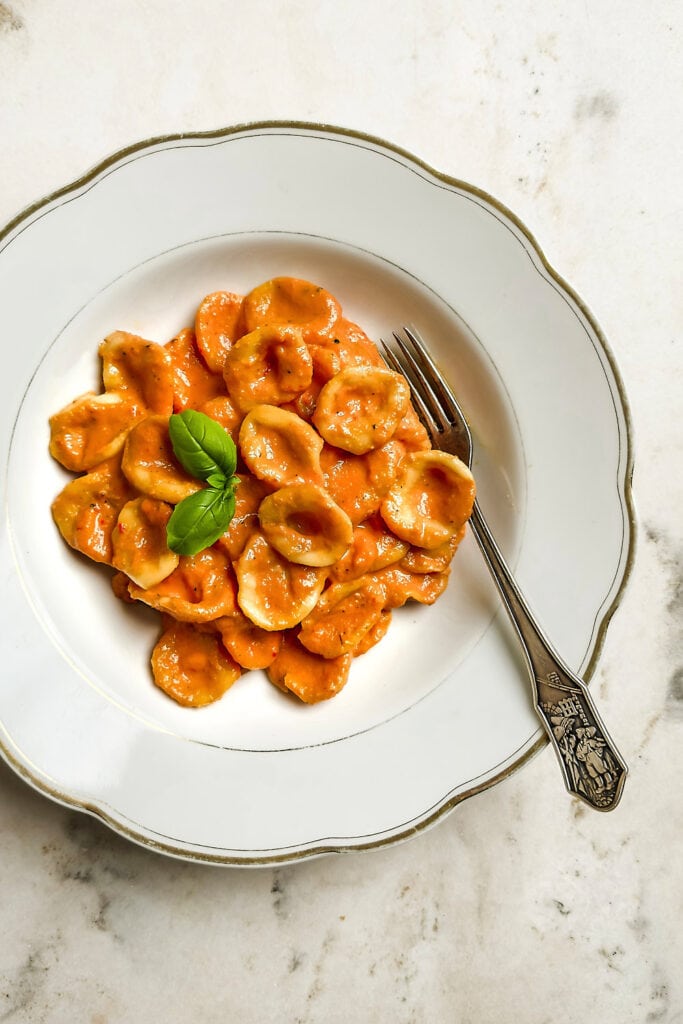

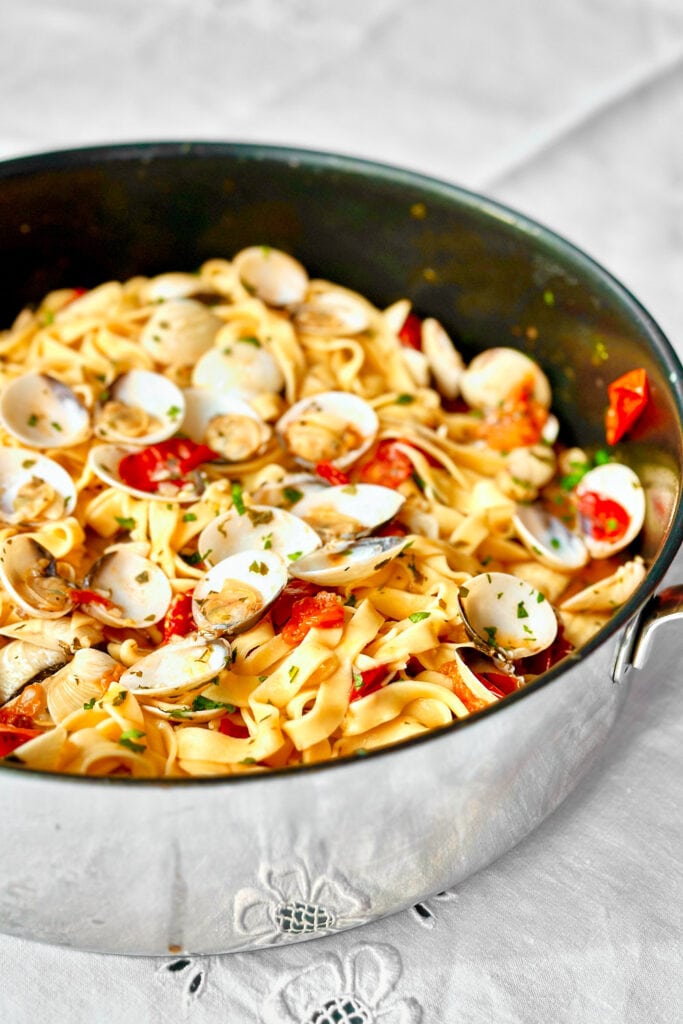
Hallo,
kann ich die Teigblätter für Ravioli auch mit dem Nudelholz ausrollen ohne Nudelmaschine?
Hallo Helga! Es geht auch ohne Nudelmaschine. Wichtig ist, den Teig mit dem Nudelholz so dünn wie möglich auszurollen. Gutes Gelingen! 🙂